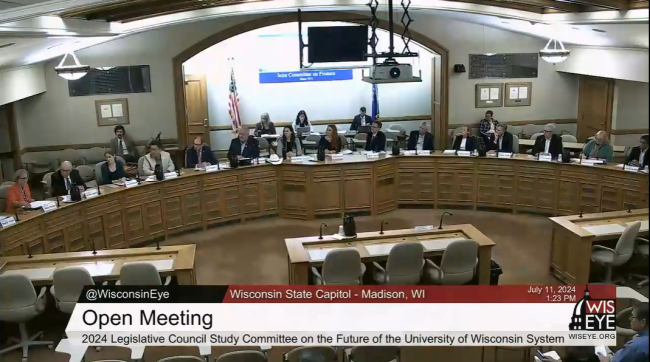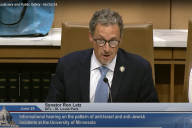You have /5 articles left.
Sign up for a free account or log in.

The study committee’s first hearing was held at the state capitol in Madison on July 11.
WisconsinEye
The Universities of Wisconsin System has faced some of the country’s steepest enrollment declines over the past five years, and now its institutions—particularly the branch campuses—are paying the price.
For years, the system was composed of two crown-jewel R-1 institutions—the University of Wisconsin at Madison and the University of Wisconsin at Milwaukee—as well as 11 regional institutions and 13 two-year branch campuses. But over the past two years that list of 26 campuses has been whittled down to 20.
The UW Platteville branch campus in Richland went first, announcing in November 2022 that in-person classes would end the following summer, effectively closing the campus. UW Milwaukee at Washington County and UW Oshkosh at Fond du Lac followed in October 2023. And since the start of 2024, three more campuses have met the same fate: UW Green Bay at Marinette, UW Milwaukee at Waukesha and UW Oshkosh at Fox Cities. Many faculty members, both at the remaining two-year branch campuses and the state’s smallest four-year institutions, have expressed worry that they will be next.
State lawmakers have decided they can no longer ignore the higher ed crisis, fueled by national demographic shifts and a declining level of public trust in the value of a college degree. They have commissioned a bicameral study committee, made up of four lawmakers and 14 public stakeholders, to analyze the UW system, evaluate its institutional infrastructure needs and make legislative recommendations for the system’s future by the end of the year. The committee held its first meeting on July 11 and is scheduled to convene four more times before the end of November.
Wisconsin is one of at least a dozen states throughout the Midwest and Northeast challenged by an oversaturated market, higher education experts say. And unless other states follow Wisconsin’s lead and start figuring out the best path forward, more public colleges will likely close. In some cases, it may already be too late.
“There just hasn’t been much creativity in thinking about those things,” said Catharine Bond Hill, managing director of Ithaka S+R, a higher ed research and consulting firm. “That has postponed change and led us to the brink, and then there are fewer options.”
‘Ripe to Reform’?
At the Wisconsin committee’s inaugural meeting, one witness, Patricia Brady, a former system administrator and author of A History of the University of Wisconsin System, recounted how the system developed. Then the committee debated where it should go next.
Several members proposed further consolidation.
“We are ripe to reform,” Scott Beightol, a UW Madison law school alum and former UW system regent, said. “I’ll put it on the table: Are there too many institutions to serve the needs of a declining demographic?”
He emphasized the need to rethink the relationship between the system’s remaining two-year branches and the state’s technical colleges—which operate independently of UW branches but often serve similar functions and are located within miles of one another. Washington County previously considered merging a two-year college with a technical college, but the idea stirred significant controversy and was eventually shot down by Governor Tony Evers.
But others, including Betsy Morgan, the provost at UW La Crosse, seemed reluctant to consolidate, pointing to the “precipitous drop” in funding as the root problem.
“We need technical schools, two-year schools, four-year schools, graduate degrees—all of those things serve our state. It’s not a choice about which one we need,” she said. “We need all of those things.”
James Langdon, a retired UW system vice president, disagreed, saying budget increases from the Legislature cannot be expected without a change in system culture first. He compared university administrators who ask for more funding to spoiled teens.
“The analogy that I submitted with my application to serve on this committee was a 16-year-old boy who wants Mom and Dad to buy him a new car, put gas in it, put insurance on him, but not tell him where he can drive it or when he needs to be home,” Landon said. “Similarly, I see that behavior at the university … ‘Give us a billion dollars and leave us alone.’ That’s not a good way to operate the state agency.”
Others still, including Bob Atwell, a former regent and the father of eight UW system alumni, suggested the top priority should be getting a better grasp on the demands of the market.
“There’s a real need to hear the voice of the noncustomers,” he said. “Why is it that people are not enrolling at the rates they did—in particular, college-age men. Why are they not buying what we’re selling? The reasons we tell ourselves, are we sure they’re really true?”
A Good Idea in Theory
Higher education policy experts say that aside from Pennsylvania, which proposed an overhaul that includes the development of a new statewide coordinating board, no other state has formalized a group to rethink the future of public higher education—likely because it’s a tall order.
“It’s a good idea to review what higher ed looks like, especially given how the former UW colleges are closing,” said Robert Kelchen, professor of education and head of the Department of Educational Leadership and Policy Studies at the University of Tennessee at Knoxville. “But the question also is, are there underlying motives for having this committee? Is the goal really, to [offer] ideas? Or is the goal to come up with an already predetermined conclusion?”
Wisconsin may have a slight advantage over other struggling Midwestern and Northeastern states in addressing the challenge of oversaturation because its higher education system is centralized, Kelchen added—but even then, challenges remain.
The Wisconsin government and UW system can decide which colleges to close or consolidate rather than relying on the institutions themselves to figure it out, he said.
“The drawback of that is then all those decisions at the system level get to be very political very quickly, and the question becomes who’s going to allow the college in their home district to be cut?”
Kelchen also noted the elephant in the room that never even came up in the first hearing: What do you do about the success of a state flagship when every other campus is struggling?
“How much should UW Madison be allowed to grow if that means cuts need to come to the rest of the system?” he asked. “If the number of new students at Madison is capped, that means that especially in-state students have to look elsewhere, and that could potentially increase enrollment at other institutions.”
Like Kelchen, Hill, from Ithaka S+R, agrees that public institutions need to be more nimble and willing to change if they are going to avoid further closures. But she also has her own concerns about using a committee to address them.
If a 2021 Ithaka case study of previous UW system consolidations is any example, she fears that committee members will rush to recommend consolidation without really looking at what it would mean for the state’s workforce needs or equity and access initiatives. If more branch campuses in rural areas close, Hill worries that not all students would transfer and some might stop out.
“If you don’t have the data,” she said, “you’re not going to be able to say, ‘What happened to some of our equity goals? Are we getting rural students into and through college?’”
So while she’s trying to be optimistic—because addressing the struggles of public higher education is better than ignoring them, she said—she will wait to see results before fully suggesting other states follow Wisconsin’s example.
“It’ll be interesting to see if a very creative, interesting report comes out with proposals that take into account not just the finances but the equity issues … then it’ll be a model that perhaps other states can follow,” she said. “But in our current political environment, that’s asking a lot.”








